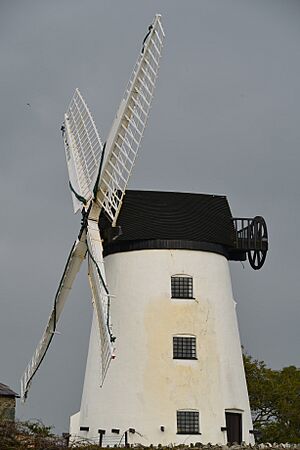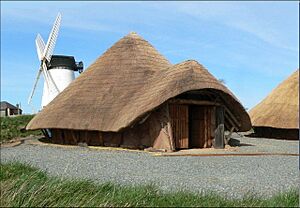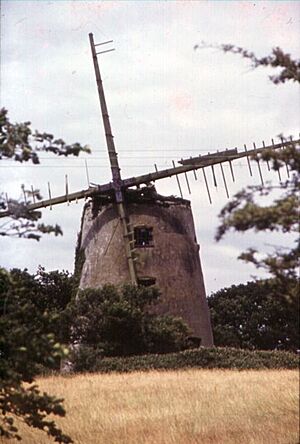Melin Llynon, Llanddeusant facts for kids
Quick facts for kids Melin Llynon, Llanddeusant |
|
|---|---|

Melin Llynon, September 2014
|
|
| Origin | |
| Mill name | Llynon Mill (Welsh: Melin Llynon) |
| Mill location | Llanddeusant |
| Grid reference | SH 3405 8523 |
| Coordinates | 53°20′16″N 4°29′38″W / 53.3379°N 4.4939°W |
| Operator(s) | Richard Holt |
| Year built | 1775 |
| Information | |
| Purpose | Corn mill |
| Type | Tower |
| Storeys | Three |
| No. of sails | Four |
| Type of sails | Common |
| Winding | Wheel and chain |
| Other information | Only working windmill in Wales |
Melin Llynon, also known as Llynon Mill, is a special gristmill (a mill that grinds grain) found near the village of Llanddeusant on the beautiful island of Anglesey. It's super important because it's the only working windmill left in all of Wales! Imagine a giant machine powered by wind, turning grain into flour – that's what Llynon Mill does.
Contents
Building a Windmill
This amazing mill was built a long time ago, between 1775 and 1776. It cost about £529 back then, which was a lot of money! It was built on land owned by a surgeon named Herbert Jones.
What Kind of Mill Is It?
Llynon Mill is a "tower mill." This means its grinding machines are inside a strong stone tower. The top part, called the "cap" (or cwch in Welsh), can turn around. This allows the big sails (called hwyliau) to catch the wind no matter which way it's blowing.
How the Mill Worked
The tower itself is about 9.3 meters tall and has four different floors. These floors held the machinery that ground corn, oats, and barley into flour. The very first miller, Thomas Jones, worked at the mill until he passed away. The job of miller was then passed down through his family for many years.
A Mill's Journey Through Time
By 1929, the mill was sometimes used and sometimes not. Sadly, by 1954, the mill had serious damage and couldn't work anymore. But don't worry, its story doesn't end there! Today, it's the only working windmill in Anglesey and Wales. You can also see a cool reconstruction of an Iron Age roundhouse hut building right there at the mill site.
Storm Damage and Repairs
In 1918, a big storm hit the mill. It damaged the cap, making it impossible for it to turn and face the wind properly. Even with the damage, the mill kept working off and on for six more years, but only when the wind blew from the southwest. Eventually, the mill had to close down and became very old and broken.
Bringing the Mill Back to Life
The Isle of Anglesey County Council bought the mill in 1978. They decided to fix it up and bring it back to life! The mill was beautifully restored and opened again on May 11, 1984. Since 1986, Llynon Mill has been making real stoneground flour again, just like in the old days.
New Owners and New Ideas
Llynon Mill was working well until 2016. Then, in 2019, Richard Holt and his family bought the mill with a long-term lease. The mill needed more repairs, but with help from different groups, including £100,000 from the UK Shared Prosperity Fund, the repairs were finished between 2022 and 2023. This was part of a bigger plan to help the North Anglesey area. After the mill was fixed, the previous miller, Lloyd Jones, came back to work there in 2024.
Richard Holt, who grew up in Anglesey, used to be a pastry chef in London, England. Now, his partner, sister, and father all work at the mill as part of their family business. They've added some fun new things to the site too! There's a chocolate factory and a donut shop called Mônuts. Llynon Mill also worked with a local distillery to create a special gin drink. You can even find a model safari on site! And don't forget the amazing reconstruction of an Iron Age roundhouse, which was built in 2007 and officially opened by Charles, who was then the future King of England.



